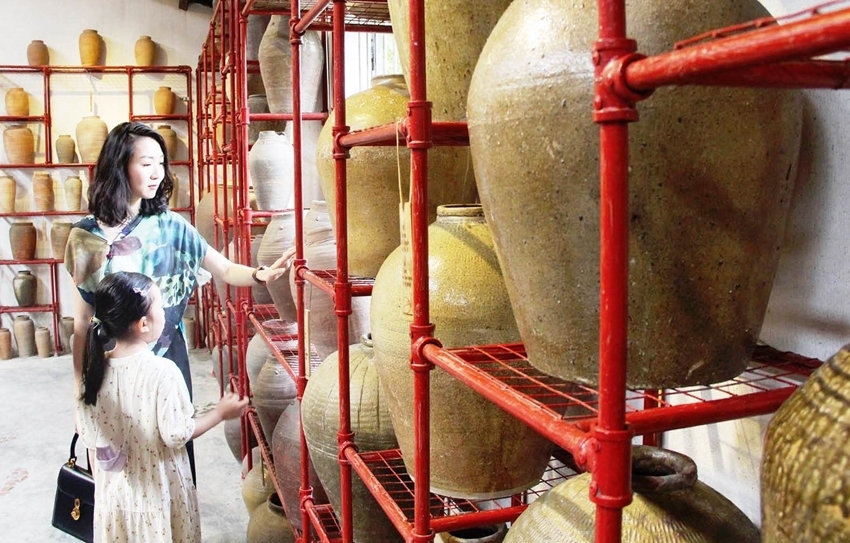    |
 |
| Visitors to the Huong River Museum of Ancient Pottery |
Many but strictly unplanned
The reason for the above proposal is that Hue Museum of Royal Antiquities is currently using Long An Palace, a work rich in architectural and artistic value belonging to the Complex of Hue Monuments as a place for work, preservation, and display of artifacts. From the proposal by the Prime Minister, looking back on Hue's museum system, it can be seen that a lot of difficulties and inadequacies remain.
Hue currently has 5 public museums: Ho Chi Minh Museum, History Museum, Fine Arts Museum, Hue Museum of Royal Antiquities, and Central Coast Nature Museum. Worth mentioning is that except for Ho Chi Minh Museum (7 Le Loi) invested and built more than 20 years back (2000), the remaining museums make the most of old works.
More specifically, similar to the Hue Museum of Royal Antiquities using Long An Palace, Thua Thien Hue History Museum also makes use of the space of the Quoc Tu Giam (Temple of Literature) monument. Since May 2020, the outdoor artifacts of this museum have been moved to 268 Dien Bien Phu (which was a former training camp belonging to the provincial Border Guards), but so far it has not been well displayed.
Diem Phung Thi Art Center and Le Ba Dang Art Center under Hue Fine Arts Museum make use of old French villas as galleries. Notably, the Central Coast Nature Museum has been approved for construction planning with an area of 99.36 hectares (in An Tay Ward) since 2013. However, for a lack of funds for construction, this museum is “staying" in the building of the Department of Science and Technology (Vy Da Ward).
In addition, the financial difficulties and the lack of experts in the specific design of the museum make most of the existing museums asynchronous, and unable to meet the standards of preservation, exhibition, and activity organization. The old designs also did not anticipate the rising number of visitors and the increasingly diverse needs of the public. Accordingly, many museums have to take advantage of inappropriate even unsafe spaces to operate. The fire at the exhibition house of Thua Thien Hue History Museum in August 2022 gave a typical example.
Besides, Thua Thien Hue is the locality with a high percentage of non-public museums (50%) with 5 licensed museums distributed mainly in Hue City: Museum of Porcelain under the Nguyen Dynasty by collector Tran Dinh Son (114 Mai Thuc Loan), Huong River Museum of Ancient Ceramics by collector Thai Kim Lan (120 Nguyen Phuc Nguyen), General Nguyen Chi Thanh Museum (144 Dang Thai Than) and Cecile Le Pham Fine Arts Museum (53 Ham Nghi). Particularly, the XQ Hue Embroidery Museum of Vietnam XQ Company (1 Pham Hong Thai), after more than 5 years of opening, now ceases operation.
Towards a worthy museum
Objectively viewed, it is undeniable that the effort to invest in modernization and improve the quality of visitor service through the application of scientific and technical advances: automatic interpretation by scanning code technology (QR code), supporting virtual reality visitors from afar with 3-D scanning technology (3D), multimedia display... However, due to the majority being utilized from available spaces, the museums in Thua Thien Hue are hardly strictly planned and not associated with urban planning.
By using culture as one of the big foundations to realize the goal of developing Hue into a centrally-run city (2025), a large and distinctive center of Southeast Asia (2030), and a Festival City of Asia (2045), building and perfecting the system of cultural and tourism institutions is a critical task and solution.
Among them, it is impossible to pay no heed to a museum worthy of the position for which Hue is aiming. In reality, Hue has an especially rich system of artifacts with tens of thousands of antiquities and dozens of national treasures, but no museum in Thua Thien Hue qualifies for rank I. The budget investment for realizing a standard and modern museum is a burning requirement of Hue to overcome the current fragmentation and backwardness.
The world trend shows that aside from the functions of collection, research, and preservation, museums turn more and more attention to the educational field. Visitors now also have high expectations of museums, where their information needs can be systematically satisfied, and where they can interact with space, time, and artifacts through modern technology.
These are also the criteria that cannot be ignored for Hue to build a modern and scientific museum always ready to respond to the ever-changing and diverse demands of the public. Naturally, the planning and design of the museum must first create a special and harmonious highlight in Hue's urban picture.
Story: Nguyen Ninh. Photo: Phan Thanh